Maximising Space with Smart Dental Surgery Cabinet Layouts

Space management is one of the most important aspects of planning a dental surgery. With limited room and multiple demands on every square metre, efficient cabinet layouts can make a significant difference to both staff and patients. A well-planned arrangement ensures that essential tools and materials are within easy reach, patient care is streamlined, and hygiene standards are maintained. Smart design of dental surgery cabinets does not simply improve workflow but also creates a professional environment that supports trust and comfort.
The Importance of Space Optimisation in Dental Surgeries
Poorly designed cabinet layouts can quickly lead to inefficiency. If cabinets are scattered without proper planning, staff spend extra time moving around during treatments, disrupting workflow and potentially increasing patient stress. Conversely, carefully optimised layouts reduce unnecessary steps and ensure procedures are carried out smoothly.
Infection control is another reason why space management is essential. Cabinets positioned without thought may blur the line between clean and dirty workflows, increasing risks of cross-contamination. Ergonomics also play a role. When tools are stored in accessible places, staff can work more comfortably, reducing strain and improving productivity.
Key Considerations in Dental Surgery Cabinet Layouts
When designing a dental surgery cabinets layout, there are several factors to consider:
- Workflow efficiency should be the starting point, ensuring every procedure can be carried out with minimal movement between treatment zones.
- Infection control requires clear segregation of clean and dirty areas within cabinetry.
- Accessibility is vital, with frequently used instruments kept within easy reach to reduce time and physical strain.
- Durability and hygiene standards matter, which is why materials should be non-porous, seamless, and resistant to chemicals and bacteria.
By addressing these considerations, practices can create a safe and efficient working environment.
Smart Design Strategies for Cabinets
Modular Cabinet Systems
Modular units allow flexibility and can be expanded or reconfigured as the clinic grows. They provide a balance between functionality and adaptability, giving surgeries the chance to modernise without needing major redesigns.
Vertical Storage Solutions
Making use of walls is particularly beneficial in small spaces. Overhead cabinets and vertical shelving free up floor area while keeping tools organised. This helps avoid clutter while creating a streamlined appearance.
Integrated Technology
Cabinets designed with built-in charging points, digital docking stations, and device storage simplify modern workflows. As more clinics rely on digital records and imaging, this integration ensures staff are not struggling with loose wires or misplaced equipment.
Concealed Storage and Waste Management
Hidden bins and compartments improve hygiene while keeping the environment professional and welcoming. Secure cabinets for controlled substances also provide safety and regulatory compliance without disrupting the surgery’s aesthetic appeal.
Layout Ideas for Maximising Space
Different layouts can be adapted depending on the size and function of the surgery:
- U-shaped layouts provide centralised access to instruments and supplies, ideal for rooms where procedures are carried out regularly.
- L-shaped layouts are space-saving solutions that work well in surgeries with limited floor area.
- Island cabinets can be effective in larger practices, enabling smooth workflow between multiple treatment zones.
- Mobile cabinet units offer flexibility, especially in rooms used for different purposes, allowing the layout to adapt depending on the procedure.
Each approach helps maximise floor space while ensuring patient comfort is not compromised.
Balancing Functionality and Aesthetics
Cabinet design should not only focus on practicality. A dental surgery is also a patient-facing environment, and the overall look plays a key role in first impressions. Choosing calming colours and professional finishes can help reduce anxiety. Cabinets should blend with the design of the room, maintaining harmony while keeping tools concealed. When cabinets are both functional and visually appealing, they create an environment that feels welcoming and professional.
Common Mistakes to Avoid
Many practices fall into traps when planning cabinet layouts. Some of the most common mistakes include:
- Adding an excessive number of cabinets can overcrowd the surgery, limiting usable space and making the environment less efficient.
- Ignoring future technology needs leads to layouts that quickly become outdated, requiring costly adjustments to fit new equipment.
- Positioning sterile and non-sterile items together increases the risk of contamination and compromises infection control standards.
- Selecting fragile finishes may look stylish but fail under daily use, resulting in wear, damage, and frequent replacement costs.
Avoiding these mistakes ensures the layout remains functional, hygienic, and durable.
Compliance and Safety in Cabinet Layouts
Cabinet designs must comply with healthcare regulations. Surfaces need to be medical-grade, seamless, and easy to clean to prevent bacterial growth. Adequate ventilation should be considered, especially where sterilisation equipment is stored. Accessibility standards also apply, ensuring all staff can reach essential tools safely and patients with mobility issues are not inconvenienced by poor layouts. Safety is central to every design decision.
Practical Tips for Dental Teams
Effective cabinet layouts benefit from direct input from the dental team. Dentists, nurses, and hygienists use the space daily, so their insights can highlight workflow issues that designers might overlook. Some practical considerations include:
- Select materials that are seamless, non-porous, and highly durable, making them easy to clean while withstanding daily clinical use.
- Position essential instruments within immediate reach, reducing unnecessary movement and ensuring staff work quickly and efficiently.
- Plan cabinet layouts with spare capacity, allowing space for new technology and equipment as the practice expands or updates services.
- Incorporate bright task lighting and ergonomic designs that support comfort, reduce strain, and improve daily efficiency for staff.
A layout that anticipates future needs avoids costly adjustments later.
The Future of Dental Surgery Cabinet Design
Looking ahead, cabinets will continue to evolve with smart features. Integrated sensors and digital monitoring may become standard, helping clinics track inventory automatically. Eco-friendly materials are also becoming popular, and in areas such as dental clinic reception design, they allow practices to adopt sustainable solutions without compromising quality. At the same time, patient-centred design is influencing cabinet layouts, with discreet storage and calming designs enhancing the overall atmosphere of the surgery.
Conclusion
Maximising space through smart cabinet layouts is an investment that delivers benefits in workflow, hygiene, and patient satisfaction. By combining practicality with aesthetics, clinics can create an environment that feels professional yet welcoming. Whether it is through modular systems, concealed storage, or integrated technology, smart cabinet planning allows practices to prepare for both present needs and future growth. At Divo Interiors LTD, we understand the unique requirements of dental surgeries and work with practices to create layouts that balance efficiency, compliance, and comfort.
- Art
- Causes
- Crafts
- Dance
- Drinks
- Film
- Fitness
- Food
- Jogos
- Gardening
- Health
- Início
- Literature
- Music
- Networking
- Outro
- Party
- Religion
- Shopping
- Sports
- Theater
- Wellness



